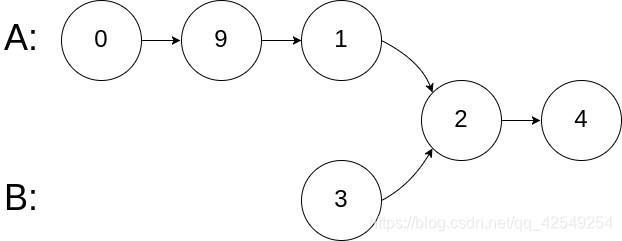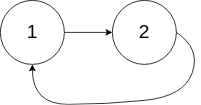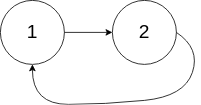19.删除链表的倒数第N个节点
给定一个链表,删除链表的倒数第 n 个节点,并且返回链表的头结点。
示例:
给定一个链表: 1->2->3->4->5, 和 n = 2.
当删除了倒数第二个节点后,链表变为 1->2->3->5.
说明:
给定的 n 保证是有效的。
进阶:
你能尝试使用一趟扫描实现吗?
/**
* Definition for singly-linked list.
* struct ListNode {
* int val;
* ListNode *next;
* ListNode(int x) : val(x), next(NULL) {}
* };
*/
class Solution {
public:
ListNode* removeNthFromEnd(ListNode* head, int n) {
ListNode *dummy = new ListNode(-1);
dummy->next = head;
ListNode *first = dummy, *second = dummy;
for(int i = 0; i < n; i ++) first = first->next;
while(first->next)
{
first = first->next;
second = second->next;
}
second->next = second->next->next;
return dummy->next;
}
};
83.删除排序链表中的重复元素
给定一个排序链表,删除所有重复的元素,使得每个元素只出现一次。
示例 1:
输入: 1->1->2
输出: 1->2
示例 2:
输入: 1->1->2->3->3
输出: 1->2->3
/**
* Definition for singly-linked list.
* struct ListNode {
* int val;
* ListNode *next;
* ListNode(int x) : val(x), next(NULL) {}
* };
*/
class Solution {
public:
ListNode* deleteDuplicates(ListNode* head) {
if(!head) return NULL;
ListNode *first, *second;
first = second = head;
while(first)
{
if(first->val != second->val)
{
second->next = first;
second = first;
}
first = first->next;
}
second->next = NULL;
return head;
}
};
206.反转链表
反转一个单链表。
示例:
输入: 1->2->3->4->5->NULL
输出: 5->4->3->2->1->NULL
进阶:
你可以迭代或递归地反转链表。你能否用两种方法解决这道题?
/**
* Definition for singly-linked list.
* struct ListNode {
* int val;
* ListNode *next;
* ListNode(int x) : val(x), next(NULL) {}
* };
*/
class Solution {
public:
ListNode* reverseList(ListNode* head) {
while(!head) return NULL;
ListNode *pre = NULL;
ListNode *cur = head;
while(cur)
{
ListNode *next = cur->next;
cur->next = pre;
pre = cur;
cur = next;
}
return pre;
}
};
/**
* Definition for singly-linked list.
* struct ListNode {
* int val;
* ListNode *next;
* ListNode(int x) : val(x), next(NULL) {}
* };
*/
class Solution {
public:
ListNode* reverseList(ListNode* head) {
if(!head || !head->next) return head;
ListNode *p = reverseList(head->next);
head->next->next = head;
head->next = NULL;
return p;
}
};
92.反转链表2
反转从位置 m 到 n 的链表。请使用一趟扫描完成反转。
说明:
1 ≤ m ≤ n ≤ 链表长度。
示例:
输入: 1->2->3->4->5->NULL, m = 2, n = 4
输出: 1->4->3->2->5->NULL
/**
* Definition for singly-linked list.
* struct ListNode {
* int val;
* ListNode *next;
* ListNode(int x) : val(x), next(NULL) {}
* };
*/
class Solution {
public:
ListNode* reverseBetween(ListNode* head, int m, int n) {
if(n == m) return head;
ListNode *dummy = new ListNode(-1);
dummy->next = head;
ListNode *b = dummy;
for(int i = 0; i < m - 1; i ++) b = b->next;
ListNode *a = b;
b = b->next;
ListNode * c = b->next;
for(int i = 0; i < n - m; i ++)
{
ListNode *next = c->next;
c->next = b;
b = c;
c = next;
}
ListNode *an = a->next;
a->next = b;
an->next = c;
return dummy->next;
}
};
61.旋转链表
给定一个链表,旋转链表,将链表每个节点向右移动 k 个位置,其中 k 是非负数。
示例 1:
输入: 1->2->3->4->5->NULL, k = 2
输出: 4->5->1->2->3->NULL
解释:
向右旋转 1 步: 5->1->2->3->4->NULL
向右旋转 2 步: 4->5->1->2->3->NULL
示例 2:
输入: 0->1->2->NULL, k = 4
输出: 2->0->1->NULL
解释:
向右旋转 1 步: 2->0->1->NULL
向右旋转 2 步: 1->2->0->NULL
向右旋转 3 步: 0->1->2->NULL
向右旋转 4 步: 2->0->1->NULL
/**
* Definition for singly-linked list.
* struct ListNode {
* int val;
* ListNode *next;
* ListNode(int x) : val(x), next(NULL) {}
* };
*/
class Solution {
public:
ListNode* rotateRight(ListNode* head, int k) {
if(!head) return head;
int n = 0;
ListNode *tail;
for(auto p = head; p; p = p->next)
{
n ++;
tail = p;
}
k %= n;
if(!k) return head;
ListNode *a = head;
for(int i = 0; i < n - k - 1; i ++)
a = a->next;
ListNode *b = a->next;
tail->next = head;
a->next = NULL;
return b;
}
};
143.重排链表
给定一个单链表 L:L0→L1→…→Ln-1→Ln ,
将其重新排列后变为: L0→Ln→L1→Ln-1→L2→Ln-2→…
你不能只是单纯的改变节点内部的值,而是需要实际的进行节点交换。
示例 1:
给定链表 1->2->3->4, 重新排列为 1->4->2->3.
示例 2:
给定链表 1->2->3->4->5, 重新排列为 1->5->2->4->3.
/**
* Definition for singly-linked list.
* struct ListNode {
* int val;
* ListNode *next;
* ListNode(int x) : val(x), next(NULL) {}
* };
*/
class Solution {
public:
void reorderList(ListNode* head) {
if(!head) return;
int n = 0;
for(auto p = head; p; p = p->next) n ++;
if(n <= 2) return;
ListNode *mid = head;
for(int i = 0; i < (n + 1) / 2 - 1; i ++) mid = mid->next;
ListNode *a = mid->next;
mid->next = NULL;
ListNode *b = a->next;
a->next = NULL;
while(b)
{
ListNode *next = b->next;
b->next = a;
a = b;
b = next;
}
b = head;
while(a)
{
ListNode *next = a->next;
a->next = b->next, b->next = a;
a = next;
b = b->next->next;
}
}
};
21.合并两个有序链表
将两个有序链表合并为一个新的有序链表并返回。新链表是通过拼接给定的两个链表的所有节点组成的。
示例:
输入:1->2->4, 1->3->4
输出:1->1->2->3->4->4
/**
* Definition for singly-linked list.
* struct ListNode {
* int val;
* ListNode *next;
* ListNode(int x) : val(x), next(NULL) {}
* };
*/
class Solution {
public:
ListNode* mergeTwoLists(ListNode* l1, ListNode* l2) {
ListNode *dummy = new ListNode(-1);
ListNode *a = dummy;
while(l1 && l2)
{
if(l1->val <= l2->val)
{
a->next = l1;
l1 = l1->next;
}
else
{
a->next = l2;
l2 = l2->next;
}
a = a->next;
}
while(l1)
{
a->next = l1;
l1 = l1->next;
a = a->next;
}
while(l2)
{
a->next = l2;
l2 = l2->next;
a = a->next;
}
return dummy->next;
}
};
160.相交链表
编写一个程序,找到两个单链表相交的起始节点。
如下面的两个链表:

在节点 c1 开始相交。
示例 1:

输入:intersectVal = 8, listA = [4,1,8,4,5], listB = [5,0,1,8,4,5], skipA = 2, skipB = 3
输出:Reference of the node with value = 8
输入解释:相交节点的值为 8 (注意,如果两个列表相交则不能为 0)。从各自的表头开始算起,链表 A 为 [4,1,8,4,5],链表 B 为 [5,0,1,8,4,5]。在 A 中,相交节点前有 2 个节点;在 B 中,相交节点前有 3 个节点。
示例 2:

输入:intersectVal = 2, listA = [0,9,1,2,4], listB = [3,2,4], skipA = 3, skipB = 1
输出:Reference of the node with value = 2
输入解释:相交节点的值为 2 (注意,如果两个列表相交则不能为 0)。从各自的表头开始算起,链表 A 为 [0,9,1,2,4],链表 B 为 [3,2,4]。在 A 中,相交节点前有 3 个节点;在 B 中,相交节点前有 1 个节点。
示例 3:

输入:intersectVal = 0, listA = [2,6,4], listB = [1,5], skipA = 3, skipB = 2
输出:null
输入解释:从各自的表头开始算起,链表 A 为 [2,6,4],链表 B 为 [1,5]。由于这两个链表不相交,所以 intersectVal 必须为 0,而 skipA 和 skipB 可以是任意值。
解释:这两个链表不相交,因此返回 null。
注意:
如果两个链表没有交点,返回 null.
在返回结果后,两个链表仍须保持原有的结构。
可假定整个链表结构中没有循环。
程序尽量满足 O(n) 时间复杂度,且仅用 O(1) 内存。
/**
* Definition for singly-linked list.
* struct ListNode {
* int val;
* ListNode *next;
* ListNode(int x) : val(x), next(NULL) {}
* };
*/
class Solution {
public:
ListNode *getIntersectionNode(ListNode *headA, ListNode *headB) {
ListNode *a = headA, *b = headB;
while(a != b)
{
if(!a) a = headB;
else a = a->next;
if(!b) b = headA;
else b = b->next;
}
return a;
}
};
141.环形链表
给定一个链表,判断链表中是否有环。
为了表示给定链表中的环,我们使用整数 pos 来表示链表尾连接到链表中的位置(索引从 0 开始)。 如果 pos 是 -1,则在该链表中没有环。
示例 1:
输入:head = [3,2,0,-4], pos = 1
输出:true
解释:链表中有一个环,其尾部连接到第二个节点。

示例 2:
输入:head = [1,2], pos = 0
输出:true
解释:链表中有一个环,其尾部连接到第一个节点。

示例 3:
输入:head = [1], pos = -1
输出:false
解释:链表中没有环。

进阶:
你能用 O(1)(即,常量)内存解决此问题吗?
/**
* Definition for singly-linked list.
* struct ListNode {
* int val;
* ListNode *next;
* ListNode(int x) : val(x), next(NULL) {}
* };
*/
class Solution {
public:
bool hasCycle(ListNode *head) {
if(!head) return head;
ListNode *fast = head->next, *slow = head;
while(fast && slow)
{
if(fast == slow) return true;
fast = fast->next;
slow = slow->next;
if(fast) fast = fast->next;
}
return false;
}
};
147.对链表进行插入排序
对链表进行插入排序。
插入排序的动画演示如上。从第一个元素开始,该链表可以被认为已经部分排序(用黑色表示)。
每次迭代时,从输入数据中移除一个元素(用红色表示),并原地将其插入到已排好序的链表中。
插入排序算法:
插入排序是迭代的,每次只移动一个元素,直到所有元素可以形成一个有序的输出列表。
每次迭代中,插入排序只从输入数据中移除一个待排序的元素,找到它在序列中适当的位置,并将其插入。
重复直到所有输入数据插入完为止。
示例 1:
输入: 4->2->1->3
输出: 1->2->3->4
示例 2:
输入: -1->5->3->4->0
输出: -1->0->3->4->5
/**
* Definition for singly-linked list.
* struct ListNode {
* int val;
* ListNode *next;
* ListNode(int x) : val(x), next(NULL) {}
* };
*/
class Solution {
public:
ListNode* insertionSortList(ListNode* head) {
ListNode *dummy = new ListNode(-1);
while(head)
{
ListNode *p = dummy;
while(p->next && head->val >= p->next->val) p = p->next;
ListNode *next = head->next;
head->next = p->next;
p->next = head;
head = next;
}
return dummy->next;
}
};
138.复制带随机指针的链表
给定一个链表,每个节点包含一个额外增加的随机指针,该指针可以指向链表中的任何节点或空节点。
要求返回这个链表的深拷贝。
示例:

输入:
{“KaTeX parse error: Expected '}', got 'EOF' at end of input: …":"1","next":{"id”:“2”,“next”:null,“random”:{“KaTeX parse error: Expected 'EOF', got '}' at position 9: ref":"2"}̲,"val":2},"rand…ref”:“2”},“val”:1}
解释:
节点 1 的值是 1,它的下一个指针和随机指针都指向节点 2 。
节点 2 的值是 2,它的下一个指针指向 null,随机指针指向它自己。
提示:
你必须返回给定头的拷贝作为对克隆列表的引用。
/*
// Definition for a Node.
class Node {
public:
int val;
Node* next;
Node* random;
Node() {}
Node(int _val, Node* _next, Node* _random) {
val = _val;
next = _next;
random = _random;
}
};
*/
class Solution {
public:
Node* copyRandomList(Node* head) {
if(!head) return head;
Node *p = head, *tempP;
while(p)
{
tempP = new Node(p->val, p->next, p->random);
tempP->next = p->next;
p->next = tempP;
p = p->next->next;
}
//复制random
p = head;
while(p)
{
if(p->random)
{
p->next->random = p->random->next;
}
else
p->next->random = NULL;
p = p->next->next;
}
p =head;
Node* copyHead = p->next;
while(p)
{
tempP = p->next;
p->next = p->next->next;
if(tempP->next)
tempP->next = tempP->next->next;
p = p->next;
}
return copyHead;
}
};
142.环形链表2
给定一个链表,返回链表开始入环的第一个节点。 如果链表无环,则返回 null。
为了表示给定链表中的环,我们使用整数 pos 来表示链表尾连接到链表中的位置(索引从 0 开始)。 如果 pos 是 -1,则在该链表中没有环。
说明:不允许修改给定的链表。
示例 1:
输入:head = [3,2,0,-4], pos = 1
输出:tail connects to node index 1
解释:链表中有一个环,其尾部连接到第二个节点。

示例 2:
输入:head = [1,2], pos = 0
输出:tail connects to node index 0
解释:链表中有一个环,其尾部连接到第一个节点。

示例 3:
输入:head = [1], pos = -1
输出:no cycle
解释:链表中没有环。

进阶:
你是否可以不用额外空间解决此题?
/**
* Definition for singly-linked list.
* struct ListNode {
* int val;
* ListNode *next;
* ListNode(int x) : val(x), next(NULL) {}
* };
*/
class Solution {
public:
ListNode *detectCycle(ListNode *head) {
if(!head) return head;
ListNode *a = head, *b = head;
while(a && b)
{
a = a->next;
b = b->next;
if(a)
a = a->next;
else return 0;
if(a == b)
{
b = head;
while(a != b)
{
a = a->next;
b = b->next;
}
return b;
}
}
return 0;
}
};
148.排序链表
在 O(n log n) 时间复杂度和常数级空间复杂度下,对链表进行排序。
示例 1:
输入: 4->2->1->3
输出: 1->2->3->4
示例 2:
输入: -1->5->3->4->0
输出: -1->0->3->4->5
/**
* Definition for singly-linked list.
* struct ListNode {
* int val;
* ListNode *next;
* ListNode(int x) : val(x), next(NULL) {}
* };
*/
class Solution {
public:
ListNode* sortList(ListNode* head) {
return head == NULL ? NULL : mergeSort(head);
}
ListNode *mergeSort(ListNode *node)
{
if(!node->next) return node;
ListNode *fast = node, *slow = node;
ListNode *breakN = node;
while(fast && fast->next)
{
fast = fast->next->next;
breakN = slow;
slow = slow->next;
}
breakN->next = NULL;
ListNode *l = mergeSort(node);
ListNode *r = mergeSort(slow);
return mergeTwoLists(l, r);
}
ListNode *mergeTwoLists(ListNode *l1, ListNode *l2)
{
ListNode *dummy = new ListNode(-1);
ListNode *p = dummy;
while(l1 && l2)
{
if(l1->val <= l2->val)
{
p->next = l1;
l1 = l1->next;
}
else
{
p->next = l2;
l2 = l2->next;
}
p = p->next;
}
p->next = (l1 == NULL ? l2 : l1);
return dummy->next;
}
};
146.LRU缓存机制
运用你所掌握的数据结构,设计和实现一个 LRU (最近最少使用) 缓存机制。它应该支持以下操作: 获取数据 get 和 写入数据 put 。
获取数据 get(key) - 如果密钥 (key) 存在于缓存中,则获取密钥的值(总是正数),否则返回 -1。
写入数据 put(key, value) - 如果密钥不存在,则写入其数据值。当缓存容量达到上限时,它应该在写入新数据之前删除最近最少使用的数据值,从而为新的数据值留出空间。
进阶:
你是否可以在 O(1) 时间复杂度内完成这两种操作?
示例:
LRUCache cache = new LRUCache( 2 /* 缓存容量 */ );
cache.put(1, 1);
cache.put(2, 2);
cache.get(1); // 返回 1
cache.put(3, 3); // 该操作会使得密钥 2 作废
cache.get(2); // 返回 -1 (未找到)
cache.put(4, 4); // 该操作会使得密钥 1 作废
cache.get(1); // 返回 -1 (未找到)
cache.get(3); // 返回 3
cache.get(4); // 返回 4
/////////////////////////////////////////
